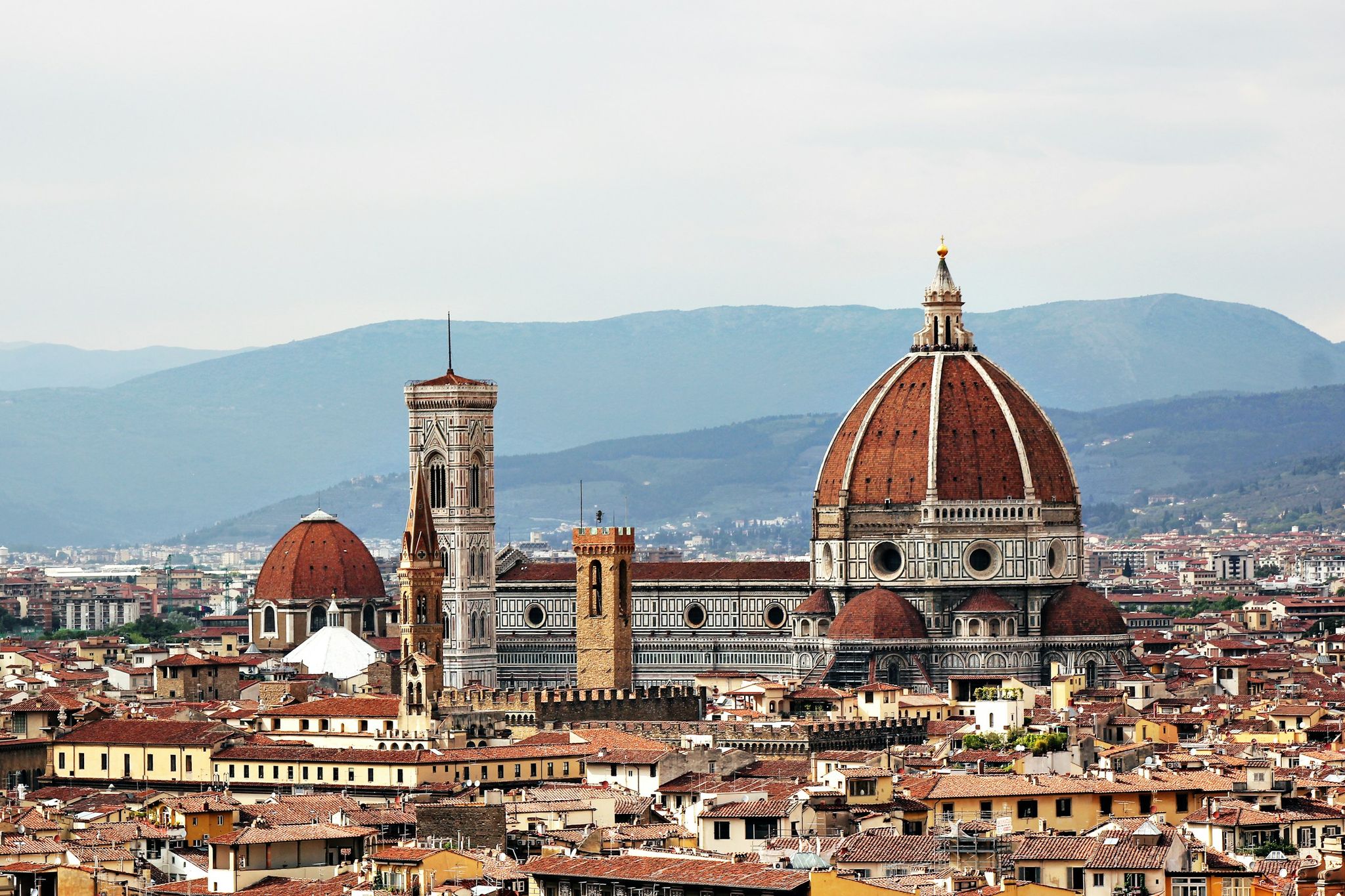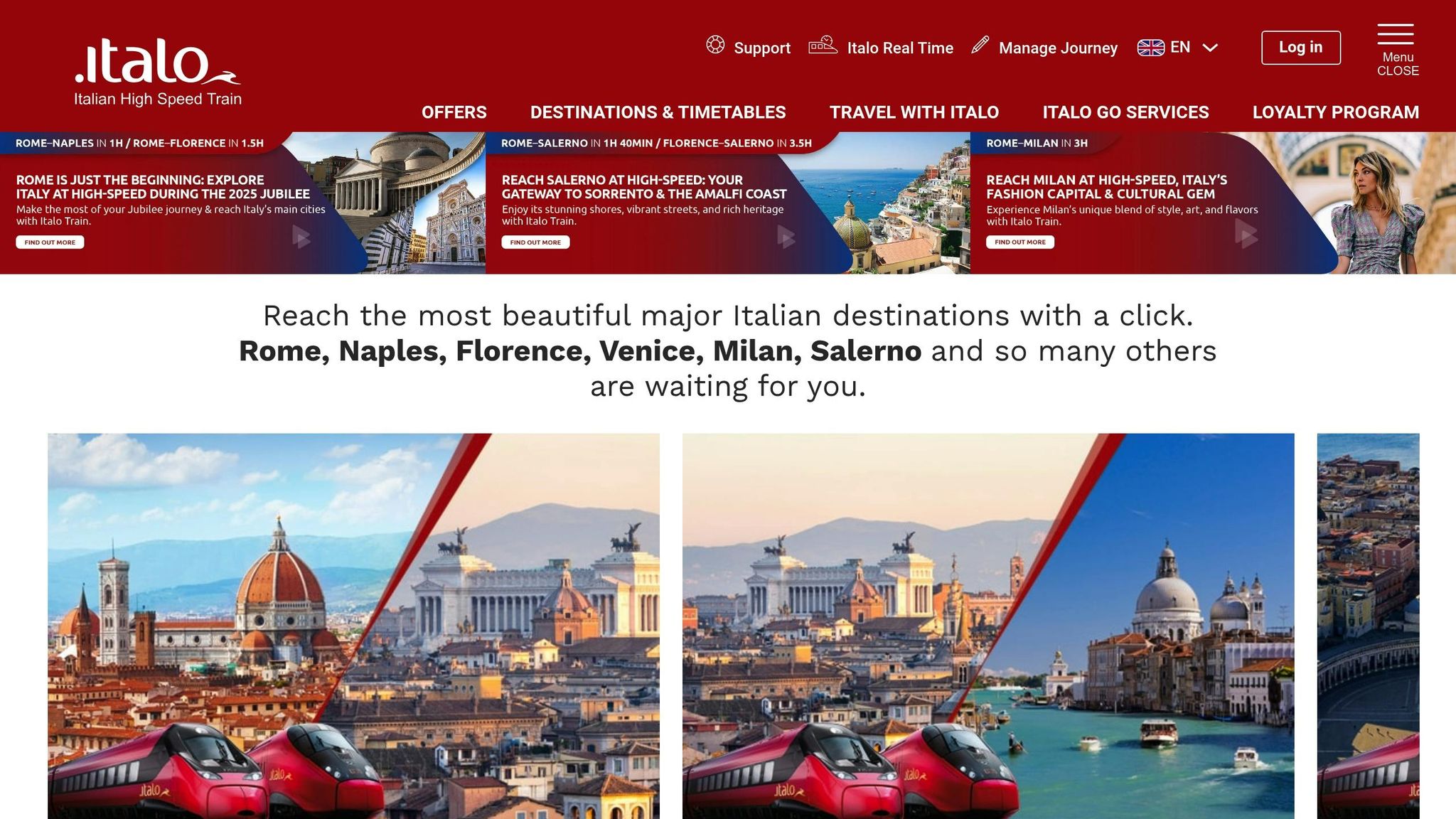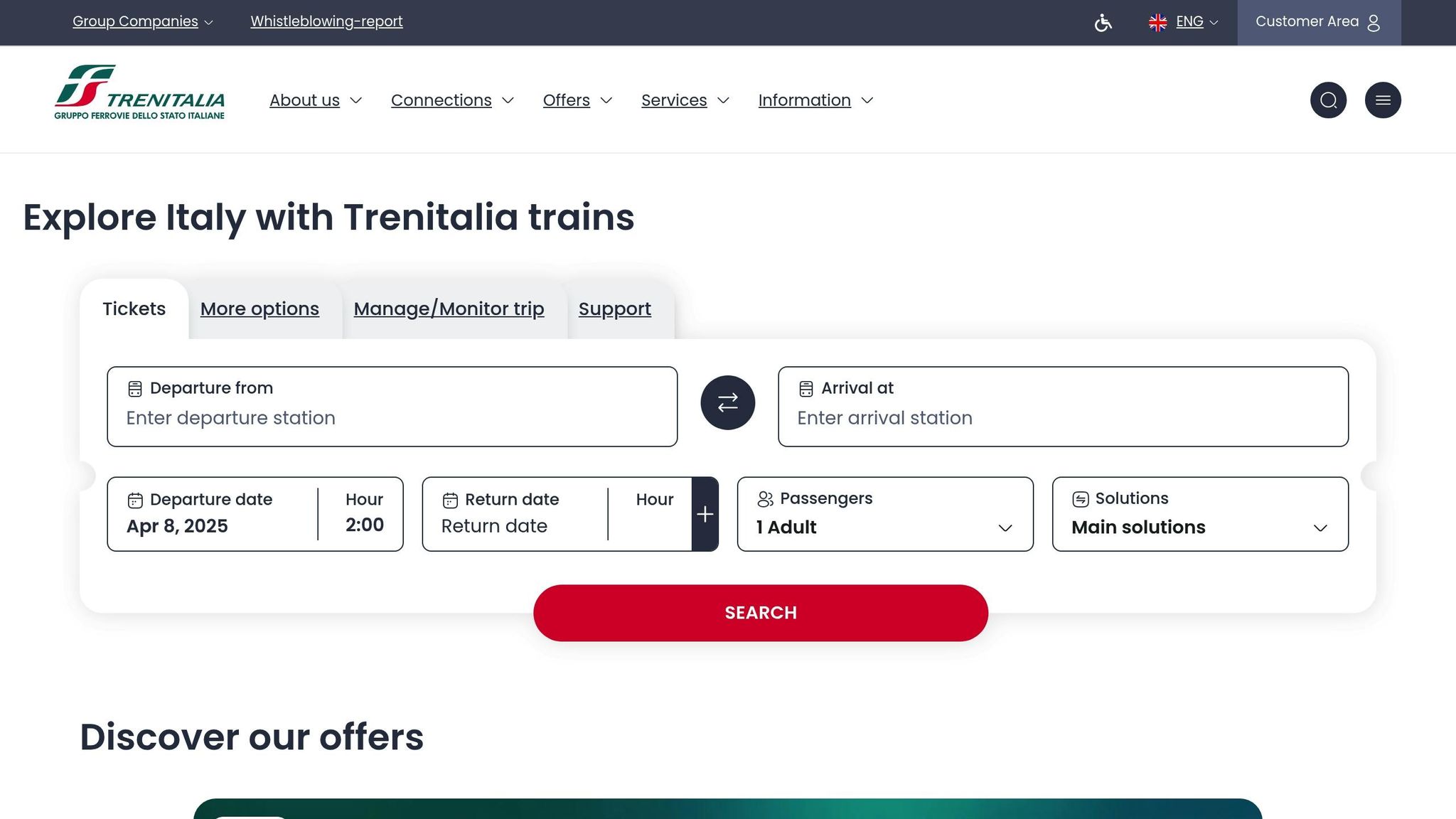Traveling from Milan to Florence by train is fast, easy, and affordable. High-speed trains connect these cities in just 1 hour and 40 minutes, with over 100 daily departures from early morning to late evening. Regional trains are available for budget-conscious travelers, though they take longer and may require transfers.
Here’s a quick overview:
- High-Speed Trains: Non-stop, modern amenities, tickets from $19.50.
- Regional Trains: Slower, scenic, cheaper but less frequent.
- Operators: Italo and Trenitalia offer multiple seat classes and discounts.
- Booking Options: Online, apps, station ticket offices, or self-service machines.
- Cost-Saving Tips: Book early, travel off-peak, or use group discounts.
Whether you prioritize speed, comfort, or savings, there’s an option for every traveler. Keep reading for ticket details, schedules, and tips to plan your trip.
Train Classes and Ticket Types
High-Speed Train Options
Traveling between Milan and Florence on high-speed trains comes with several seating options. These trains require seat reservations, which are already included in the ticket price. For a more relaxed alternative, regional trains are also available and are outlined below.
Regional Train Options
Regional trains provide standard and first-class seating without requiring seat reservations, though passengers can choose to reserve a seat if they prefer. These trains make more stops along the route, so the travel time is longer compared to high-speed options. Both high-speed and regional services offer a range of discounts.
Available Discounts
Discounted fares are offered for children, seniors, and groups. These reduced rates often require proof of eligibility or advance purchase. Be sure to check the specific fare conditions when booking your tickets.
Milan to Florence on Italy’s Frecciarossa
Train Companies and Services
Two main rail operators, Italo and Trenitalia, provide train services between Milan and Florence. Both run modern high-speed trains with various service levels and onboard features.
Italo Services
Italo runs over 46 high-speed trains daily between Milan and Florence [3]. They offer three travel classes:
- Lounge Italo Club: Premium seats with extra-wide armchairs, dedicated catering, Fast Track access, and personal entertainment screens.
- Prima Business Class: Reclining leather seats, welcome service, and Fast Track access for a more comfortable journey.
- Smart Class: Standard seating with leather chairs, power outlets, and independent tables.
All passengers enjoy complimentary Wi-Fi and access to a snack area with vending machines. Ticket prices start at €17.90 ($19.50) [3].
"In March 2024, Italo introduced a new ‘Travel Pack’ for frequent travelers, offering flexibility and savings of up to 80% on routes like Milan to Florence. The ‘Travel Pack 10’ is valid for 180 days, while the ‘Travel Pack Special’ is valid for 30 days." (Source: Italotreno.com, 2024)
Trenitalia Services
Trenitalia operates around 60 trains daily on the Milan–Florence route [1], with both high-speed and standard options. Their high-speed "Freccia" trains include:
- Air conditioning in all cars
- Power outlets at every seat
- Free Wi-Fi
- A full-service cafe car
- Seat-side food cart service
- Luggage storage racks in each car
Regional Trains
For budget-conscious travelers, regional trains offer an affordable alternative. While slower and often requiring connections, they provide basic amenities and the chance to enjoy scenic views of the Italian countryside.
Route Options
Non-Stop Routes
High-speed trains run directly between Milano Centrale and Florence’s Santa Maria Novella station, covering 190 miles in about 1 hour and 40 minutes [1][2]. These direct trains are the quickest way to travel, with approximately 60 departures each day [1][2]. Milano Centrale offers modern facilities, while Santa Maria Novella is conveniently situated in the heart of Florence.
Here’s a quick look at key stations along this route:
Major Station Stops
| Station | Features |
|---|---|
| Milan Centrale | 24 platforms; FRECCIALounge and Italo Club; luggage storage |
| Milan Porta Garibaldi | Links to metro and suburban lines |
| Bologna | Major transfer hub with access to regional trains |
| Florence S.M. Novella | Centrally located; primary station in Florence |
Other Route Options
If you’re looking for a more budget-friendly alternative, regional trains are available. These routes pass through the scenic Lombardy, Emilia-Romagna, and Tuscany regions. However, they take longer and often require transfers [1][2]. On weekends and holidays, service frequency may decrease, which can add to travel times [1][2]. Regional trains are a good choice for travelers focused on saving money.
How to Buy Tickets
Train Company Websites
Trenitalia and Italo make booking easy through their websites. Trenitalia supports payment methods like PayPal, Apple Pay, Google Pay, and major credit cards. Italo’s website stands out for having no booking fees. To book online, simply select your travel dates, pick a seat class, provide passenger details, and complete payment. If online booking isn’t your preference, you can also visit station offices or use mobile apps.
Station Ticket Offices
You can purchase tickets at major stations such as Milano Centrale or Florence Santa Maria Novella. Stations offer staffed ticket offices and self-service machines for added convenience.
Here’s a quick comparison of ticket purchase methods:
| Purchase Method | Advantages | Important Notes |
|---|---|---|
| Ticket Office | Personal assistance; accepts cash | May involve waiting during busy times |
| Automatic Ticket Machine | Quick and easy; card payments accepted | Available at most stations |
| On-Board Purchase | Great for last-minute needs | Higher prices; cash payments only [4] |
If you’re looking for flexibility, mobile apps are becoming a popular choice for travelers.
Booking Apps
Booking apps offer features like reservation management, real-time train tracking, and instant updates on delays or platform changes. The Trenitalia app also lets you store tickets in Google/Apple Wallet, plan door-to-door trips, and receive smart notifications. Both Trenitalia and Italo apps allow you to manage bookings, check train statuses, and receive updates on the go. With multiple payment options built in, these apps make securing your tickets fast and convenient for your Milan–Florence trip.
Prices and Savings
This section breaks down ticket prices, discount options, and rail pass details for traveling the Milan–Florence route.
Ticket Prices by Class
High-speed trains provide two class options: first and second. Prices depend on demand and booking time, but second-class tickets usually stay under $50 if purchased early[5].
| Class Type | Features | Additional Notes |
|---|---|---|
| First Class | Extra legroom, wider seats, complimentary services | Higher price range |
| Second Class | Comfortable standard seating | Budget-friendly option |
In addition to class differences, there are ways to reduce travel costs.
Cost-Saving Methods
You can lower travel expenses with these tips:
- Travel during off-peak hours for reduced fares.
- Watch for seasonal deals from train operators.
- Choose slower regional trains for cheaper tickets.
- Take advantage of group discounts when traveling with others.
Rail Pass Information
If you’re considering a rail pass, think about your overall travel plans.
"Not for most people – think carefully before buying a rail pass, especially if your trip doesn’t extend beyond Italy." – Rick Steves[5]
Rail passes might not be ideal for this specific route. Key points to know:
- Rail passes only cover Trenitalia services, excluding private operators like Italo[5].
- Seat reservations cost around $12 per leg on Le Frecce and $10 on EuroCity/InterCity trains[5].
For shorter trips within Italy, like Milan to Florence, individual tickets are usually more cost-effective. However, if your itinerary includes extensive travel across Italy or Europe, a rail pass could save money when factoring in reservation fees.
Train Times and Frequency
Knowing train schedules can help you plan a smooth trip between Milan and Florence.
Fast Train Schedule
High-speed trains connect Milano Centrale to Florence with about 60 departures daily. The quickest trips take roughly 1 hour and 40 minutes [2]. Trains run from 5:00 a.m. to 11:18 p.m., with 1–2 departures per hour during busy periods [2].
Service Frequency:
- Peak Hours: Every 30–60 minutes
- Off-Peak Hours: Every 60 minutes
- Weekends/Holidays: Fewer departures
If you’re looking for other options, regional trains provide additional services, though they run less often.
Slower Train Schedule
Regional trains involve transfers and operate less frequently than high-speed options [1]. On weekends and holidays, schedules are even more limited, and trips may take longer [1][2]. All trains arrive at Florence’s Santa Maria Novella station.
Extra Costs and Rules
Knowing about extra fees and ticket policies can help you avoid surprises during your trip.
Required Fees
Here are some additional charges you might encounter:
- €10 penalty for boarding a different train without prior notification.
- Porter service at Milano Centrale and Firenze SMN costs €5 if booked in advance.
- Bagaglio Facile service: €25 for the first bag, €20 for each extra bag.
- Animal supplement: €2 for unlimited travel on supra-regional routes until the end of the service day.
Check the next section for ticket flexibility and refund details.
Ticket Changes and Refunds
Different ticket types come with varying rules for changes and refunds:
| Ticket Type | Changes Allowed | Refunds | Boarding a Different Train |
|---|---|---|---|
| Base | Yes, with a price difference | Yes, minus 20% | Yes, with a €10 penalty |
| Economy | Yes, but must pay the Base fare difference | No | Not allowed |
| Super Economy | Not allowed | No | Not allowed |
For regional digital tickets ("ORDINARIA"), you can make unlimited changes to the date and time until 11:59 p.m. the day before your trip. Refunds are also possible if requested by the same deadline.
Important Luggage Rules
- No extra fees for bringing luggage on Italian trains.
- Passengers are responsible for loading and stowing their own bags.
- Theft insurance is included.
- The Bagaglio Facile service operates Monday through Friday at most stations, with weekend service available in Milan and Florence.
Pet Travel Regulations
Dogs must be muzzled, leashed, and have a current registry certificate. Guide dogs are allowed to travel for free.
Summary
The Milan–Florence train journey offers a variety of options to fit different travel needs. Both high-speed and regional trains connect these two cities, each catering to specific preferences and budgets [1][2].
Here’s what the route includes:
- Frequent daily departures
- Multiple service classes to accommodate various budgets
- Amenities available on high-speed trains
- Booking options through several platforms
Key points to keep in mind:
- Seat reservations are required on high-speed trains
- Schedules may change on weekends and holidays
- Booking early often secures lower fares
- Children aged 3 and under can travel for free if they share a seat
For those looking to save money, regional trains are a budget-friendly option, though they take longer than high-speed services. Check earlier sections for detailed pricing and schedules.
This journey combines convenience, comfort, and affordability, making it an excellent choice for traveling between these two historic cities. Whether you prefer the speed and amenities of high-speed trains or the cost savings of regional ones, there’s an option to suit your needs.



